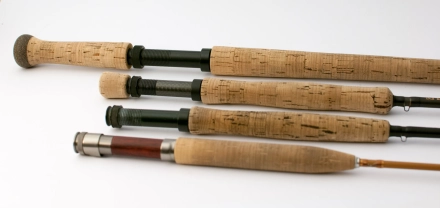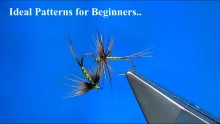Fly rods are fishing rods built specifically for fly-fishing and are similar to any fishing rod in many ways, but also very different.
A fly rod is a fishing rod constructed for fly-fishing. It is in broad principle made like any other fishing rod, but there are some major differences, and an ordinary fishing rod can't be used for fly-fishing.
The rod is typically very lightweight and thin compared to most fishing rods. It's still a thin, tapered tube made from carbon fiber. It has rings to control the line (AKA guides) and a handle as well as a reel seat where you mount the reel, but that's also about where the similarity ends.
The guides are often very small and mounted close to the blank - the rod itself - and the reel seat is located at the very lower end of the rod, below the handle when you hold the rod upright. The reel is mounted here to create balance in the rod when it's used, and the reel is not used as a baitcasting or spinning reel to pull in line when fishing. Many fly-anglers pull line off the reel when they start fishing and don't wind it back on the reel until they are done for the day.
Fly rods are classified like spinning rods after length and the weight they are supposed to cast, but unlike spinning rods, the weight is that of the line and not of the lure. Since it's the line that is used to cast the very light fly, it's the line that requires a suitable rod to cast well,.
Rod classes - which is actually line classes - are numbers called AFFTA classes. This was previously called AFTM and that acronym is still used quite often. Classes range from 0 (which is very, very lightweight and quite rare) to about 14 and 15, which is heavy and also quite rare. The rod class or line class is sometimes designated by the number sign #.
Rods for the lowest line classes 0, 1 and 2 are rods for small flies on light lines aimed at small fish on small waters.
Rods for the highest line classes over 10 and 11 are mainly used for larger fish in larger waters - either saltwater rods for tarpon, tuna, billfish and other large species or salmon rods used for large salmon and steelhead on large rivers.
The most common line classes range from 3 and 4 to about 8 and 9.
Some rods are specified to be useful for several line classes like a 3-4 weight or a 10-11 weight, which has enough leeway to handle several different line classes. Since neither rods nor lines are scientifically calibrated, matching rod and line is often a question of trying it out rather than trusting the indicated weights.
Some manufacturers also write a recommended casting weight in ounces and grams on their rods, but these numbers can be hard to use unless you know exactly what your fly line weighs.
Rod lengths are governed by the casting style and the space, and small rods for use on small streams with overhanging vegetation are in the 6-7 foot range while the longer ones are 10 to 13 foot, which can be great for boat fishing, certain casting styles or reaching over reeds and growth on a river or lake bank.
The most common rod lengths are 7-8-9 feet, and rods in this length are useful in most places for the most common kinds of fishing. Rods can also be measured in half feet and sometimes in inches.
The rod is almost always made from several pieces (sections) that connect via ferrules (joints). The number of sections vary, but 2 and 4 piece rods are the most common.
You will also find so called two hand rods - sometimes called spey rods - which are longer rods up to 15' with longer handles both above and below the reel seat, used for a special style of casting known as two hand or spey casting.
Rod specifications can be written in different ways.
A 6' 2 pc. #4 rod would cast a 4 weight line, be 6 feet or 1.8 meters long and break down to two pieces for transport and storage.
A 6-7 weight 9'4" 3 piece rod is meant to cast a 6 or a 7 weight line and is 9 feet and 4 inches long or about 2.8 meters long and can be taken apart into three sections.
The vast majority of modern fly rods are made from carbon fiber like all other fishing rods, but some fly rods are made from glass fiber or bamboo.
The handles are almost exclusively made from cork, sometimes mixed with so called burl - cork mass in different colors - but very rarely made from neoprene as it's often seen on spinning rods. The handle shape varies depending on the rod weight and usage and on the preference of the angler.
The reel seats vary in construction with the rod weight and intended use. Lightweight rods have really delicate reel seats where the reel is secured with simple rings that slide over the reel's foot. The normal system is uses a threaded ring that is screwed over one reel foot while the other is inserted into a recess in the handle. Heavier reel seats may have two rings that can interlock for extra security. Materials also vary and while lighter rods for freshwater use are often nickle-silver with wooden inlays, saltwater and salmon rods are usually full aluminum constructions built to withstand saltwater and heavy loads.
The guides are made from steel and can have inlays in the form of ceramics or other materials. The lowermost guides are called stripping guides and are typically larger and sturdier than the remaining guides, which are often simple snake guides made from a single piece of coiled steel. The topmost guide is called the tip top, and is mostly just a simple pear-shaped steel ring.
Fly-rods are almost always more expensive than spinning rods of the same length and basic construction. Mainly because they are made by hand in smaller numbers by smaller manufacturers, but also because fly-anglers seem willing to pay more for their gear than most anglers.
- Log in to post comments























Great article Martin
Great article Martin!
Although I fly fish for 8 years now, I still remember how eager I was looking for this kind of information back then.
I'm sure a lot of people who want to discover fly fishing will appreciate this kind of information.
A fly rod is a lever
A fly rod is a lever designed to accelerate a load. The load (effective resistance) and degree of acceleration are determined by the fly caster. It's a poor workman who blames his tools.
Some years ago on a
Some years ago on a Sunday morning I was flyfishing in the Main river in Frankfurt. Two boys where rowing on the river. When they had passed me one said to the other:"Did you see his rod? He is fishing with a damaged rod"!
I imagine that they didn't see any fly rod before......